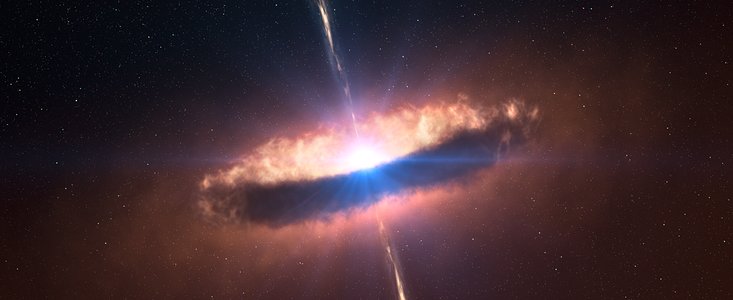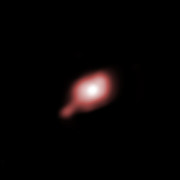Press Release
Unravelling the Mystery of Massive Star Birth
All Stars are Born the Same Way
14 July 2010
Astronomers have obtained the first image of a dusty disc closely encircling a massive baby star, providing direct evidence that massive stars form in the same way as their smaller brethren. This discovery, made thanks to a combination of ESO’s telescopes, is described in an article in this week’s issue of Nature.
“Our observations show a disc surrounding an embryonic young, massive star, which is now fully formed,” says Stefan Kraus, who led the study. “One can say that the baby is about to hatch!”
The team of astronomers looked at an object known by the cryptic name of IRAS 13481-6124. About twenty times the mass of our Sun and five times its radius, the young central star, which is still surrounded by its pre-natal cocoon, is located in the constellation of Centaurus, about 10 000 light-years away.
From archival images obtained by the NASA Spitzer Space Telescope as well as from observations done with the APEX 12-metre submillimetre telescope, astronomers discovered the presence of a jet.
“Such jets are commonly observed around young low-mass stars and generally indicate the presence of a disc,” says Kraus.
Circumstellar discs are an essential ingredient in the formation process of low-mass stars such as our Sun. However, it is not known whether such discs are also present during the formation of stars more massive than about ten solar masses, where the strong light emitted might prevent mass falling onto the star. For instance, it has been proposed that massive stars might form when smaller stars merge.
In order to discover and understand the properties of this disc, astronomers employed ESO’s Very Large Telescope Interferometer (VLTI). By combining light from three of the VLTI’s 1.8-metre Auxiliary Telescopes with the AMBER instrument, this facility allows astronomers to see details equivalent to those a telescope with a mirror of 85 metres in diameter would see. The resulting resolution is about 2.4 milliarcseconds, which is equivalent to picking out the head of a screw on the International Space Station, or more than ten times the resolution possible with current visible-light telescopes in space.
With this unique capability, complemented by observations done with another of ESO’s telescopes, the 3.58-metre New Technology Telescope at La Silla, Kraus and colleagues were able to detect a disc around IRAS 13481-6124.
“This is the first time we could image the inner regions of the disc around a massive young star”, says Kraus. “Our observations show that formation works the same for all stars, regardless of mass.”
The astronomers conclude that the system is about 60 000 years old, and that the star has reached its final mass. Because of the intense light of the star — 30 000 times more luminous than our Sun — the disc will soon start to evaporate. The flared disc extends to about 130 times the Earth–Sun distance — or 130 astronomical units (AU) — and has a mass similar to that of the star, roughly twenty times the Sun. In addition, the inner parts of the disc are shown to be devoid of dust.
“Further observations with the Atacama Large Millimeter/submillimeter Array (ALMA), currently being constructed in Chile, could provide much information on these inner parts, and allow us to better understand how baby massive stars became heavy,” concludes Kraus.
More information
This research was presented in a paper to appear in this week issue of Nature (“A hot compact dust disk around a massive young stellar object”, by S. Kraus et al.).
The team is composed of Stefan Kraus (University of Michigan, USA), Karl-Heinz Hofmann, Karl M. Menten, Dieter Schertl, Gerd Weigelt, Friedrich Wyrowski, and Anthony Meilland (Max-Planck-Institut für Radioastronomie, Bonn, Germany),Karine Perraut (Laboratoire d'Astrophysique de Grenoble, France), Romain Petrov and Sylvie Robbe-Dubois (Université de Nice Sophia-Antipolis/CNRS/Observatoire de la Côte d’Azur, France), Peter Schilke (Universität zu Köln, Germany), and Leonardo Testi (ESO).
Links
Contacts
Stefan Kraus
University of Michigan
USA
Tel: +1 734 615 7374
Email: stefankr@umich.edu
Richard Hook
ESO
Garching bei München, Germany
Tel: +49 89 3200 6655
Email: rhook@eso.org
Henri Boffin
ESO, La Silla Paranal and E-ELT Press Officer
Garching bei München, Germany
Tel: +49 89 3200 6222
Cell: +49 174 515 43 24
Email: hboffin@eso.org
About the Release
| Release No.: | eso1029 |
| Name: | Protoplanetary disc |
| Type: | Milky Way : Star : Circumstellar Material : Disk : Protoplanetary |
| Facility: | New Technology Telescope, Very Large Telescope, Very Large Telescope Interferometer |
| Instruments: | AMBER, LABOCA, SABOCA |
| Science data: | 2010Natur.466..339K |
Our use of Cookies
We use cookies that are essential for accessing our websites and using our services. We also use cookies to analyse, measure and improve our websites’ performance, to enable content sharing via social media and to display media content hosted on third-party platforms.
ESO Cookies Policy
The European Organisation for Astronomical Research in the Southern Hemisphere (ESO) is the pre-eminent intergovernmental science and technology organisation in astronomy. It carries out an ambitious programme focused on the design, construction and operation of powerful ground-based observing facilities for astronomy.
This Cookies Policy is intended to provide clarity by outlining the cookies used on the ESO public websites, their functions, the options you have for controlling them, and the ways you can contact us for additional details.
What are cookies?
Cookies are small pieces of data stored on your device by websites you visit. They serve various purposes, such as remembering login credentials and preferences and enhance your browsing experience.
Categories of cookies we use
Essential cookies (always active): These cookies are strictly necessary for the proper functioning of our website. Without these cookies, the website cannot operate correctly, and certain services, such as logging in or accessing secure areas, may not be available; because they are essential for the website’s operation, they cannot be disabled.
Functional Cookies: These cookies enhance your browsing experience by enabling additional features and personalization, such as remembering your preferences and settings. While not strictly necessary for the website to function, they improve usability and convenience; these cookies are only placed if you provide your consent.
Analytics cookies: These cookies collect information about how visitors interact with our website, such as which pages are visited most often and how users navigate the site. This data helps us improve website performance, optimize content, and enhance the user experience; these cookies are only placed if you provide your consent. We use the following analytics cookies.
Matomo Cookies:
This website uses Matomo (formerly Piwik), an open source software which enables the statistical analysis of website visits. Matomo uses cookies (text files) which are saved on your computer and which allow us to analyze how you use our website. The website user information generated by the cookies will only be saved on the servers of our IT Department. We use this information to analyze www.eso.org visits and to prepare reports on website activities. These data will not be disclosed to third parties.
On behalf of ESO, Matomo will use this information for the purpose of evaluating your use of the website, compiling reports on website activity and providing other services relating to website activity and internet usage.
Matomo cookies settings:
Additional Third-party cookies on ESO websites: some of our pages display content from external providers, e.g. YouTube.
Such third-party services are outside of ESO control and may, at any time, change their terms of service, use of cookies, etc.
YouTube: Some videos on the ESO website are embedded from ESO’s official YouTube channel. We have enabled YouTube’s privacy-enhanced mode, meaning that no cookies are set unless the user actively clicks on the video to play it. Additionally, in this mode, YouTube does not store any personally identifiable cookie data for embedded video playbacks. For more details, please refer to YouTube’s embedding videos information page.
Cookies can also be classified based on the following elements.
Regarding the domain, there are:
- First-party cookies, set by the website you are currently visiting. They are stored by the same domain that you are browsing and are used to enhance your experience on that site;
- Third-party cookies, set by a domain other than the one you are currently visiting.
As for their duration, cookies can be:
- Browser-session cookies, which are deleted when the user closes the browser;
- Stored cookies, which stay on the user's device for a predetermined period of time.
How to manage cookies
Cookie settings: You can modify your cookie choices for the ESO webpages at any time by clicking on the link Cookie settings at the bottom of any page.
In your browser: If you wish to delete cookies or instruct your browser to delete or block cookies by default, please visit the help pages of your browser:
Please be aware that if you delete or decline cookies, certain functionalities of our website may be not be available and your browsing experience may be affected.
You can set most browsers to prevent any cookies being placed on your device, but you may then have to manually adjust some preferences every time you visit a site/page. And some services and functionalities may not work properly at all (e.g. profile logging-in, shop check out).
Updates to the ESO Cookies Policy
The ESO Cookies Policy may be subject to future updates, which will be made available on this page.
Additional information
For any queries related to cookies, please contact: pdprATesoDOTorg.
As ESO public webpages are managed by our Department of Communication, your questions will be dealt with the support of the said Department.





